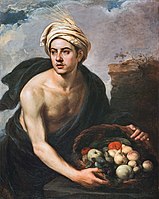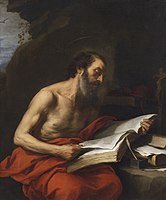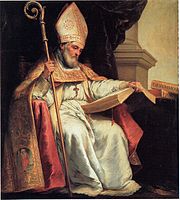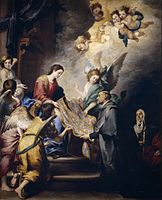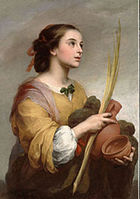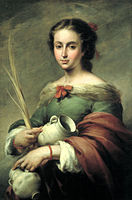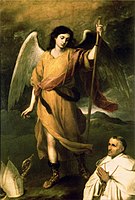Bartolomé Esteban Murillo: Difference between revisions
No edit summary |
Undid revision 882949406 by 81.128.137.107 (talk) - unexplained removal of image |
||
| Line 80: | Line 80: | ||
Bartolome Esteban Perez Murillo 012.jpg|''Joseph and [[Potiphar|Potiphar's Wife]]'', c. 1640–45, [[Cathedral of Seville]], [[Spain]] |
Bartolome Esteban Perez Murillo 012.jpg|''Joseph and [[Potiphar|Potiphar's Wife]]'', c. 1640–45, [[Cathedral of Seville]], [[Spain]] |
||
Personificación del Verano.jpg|''Young Man with a Basket of Fruit'' or ''Personification of Summer'', c. 1640–50 |
Personificación del Verano.jpg|''Young Man with a Basket of Fruit'' or ''Personification of Summer'', c. 1640–50 |
||
La gallega de la moneda.jpg|''The Girl with a Coin'' or ''Girl of [[Galicia (Spain)|Galicia]]'', c. 1645–50 |
|||
Bartolomé Esteban Murillo - The Young Beggar.JPG|''[[The Young Beggar]]'', c. 1645, [[Musée du Louvre]], [[Paris]], [[France]] |
Bartolomé Esteban Murillo - The Young Beggar.JPG|''[[The Young Beggar]]'', c. 1645, [[Musée du Louvre]], [[Paris]], [[France]] |
||
Bartolomé Esteban Perez Murillo - Trauben- und Melonenesser.jpg|'' Boys Eating Grapes and Melon'', c. 1645–46, Alte Pinakothek |
Bartolomé Esteban Perez Murillo - Trauben- und Melonenesser.jpg|'' Boys Eating Grapes and Melon'', c. 1645–46, Alte Pinakothek |
||
Revision as of 12:41, 12 February 2019
Bartolomé Esteban Murillo | |
|---|---|
 Self-portrait, c. 1670–73 (detail) | |
| Born | late December 1617; baptised January 1, 1618 |
| Died | April 3, 1682 (aged 64) Seville, Spain |
| Nationality | Spanish |
| Known for | painting, drawing |
| Movement | Baroque |
You can help expand this article with text translated from the corresponding article in Spanish. (November 2018) Click [show] for important translation instructions.
|
Bartolomé Esteban Murillo (born late December 1617, baptized January 1, 1618 – April 3, 1682) was a Spanish Baroque painter. Although he is best known for his religious works, Murillo also produced a considerable number of paintings of contemporary women and children. These lively, realist portraits of flower girls, street urchins, and beggars constitute an extensive and appealing record of the everyday life of his times.
Childhood
Murillo was born to Gaspar Esteban and María Pérez.[1] He may have been born in Seville or in Pilas, a smaller Andalusian town.[2] It is clear that he was baptized in Seville in 1618, the youngest son in a family of fourteen. His father was a barber and surgeon. After his parents died in 1627 and 1628, he became a ward of his sister's husband, Juan Agustín Lagares.[1] Murillo seldom used his father's surname, and instead took his surname from his maternal grandmother, Elvira Murillo.[1]
Career

Murillo began his art studies in Seville under Juan del Castillo, who was a relative of his mother (Murillo's uncle, Antonio Pérez, was also a painter).[1] His first works were influenced by Zurbarán, Jusepe de Ribera and Alonzo Cano, and he shared their strongly realist approach. The great commercial importance of Seville at the time ensured that he was subject to artistic influences from other regions. He became familiar with Flemish painting and the "Treatise on Sacred Images" of Molanus (Ian van der Meulen or Molano). As his painting developed, his more important works evolved towards the polished style that suited the bourgeois and aristocratic tastes of the time, demonstrated especially in his Roman Catholic religious works.
In 1642, at the age of 26, he moved to Madrid, where he most likely became familiar with the work of Velázquez, and would have seen the work of Venetian and Flemish masters in the royal collections; the rich colors and softly modeled forms of his subsequent work suggest these influences.[3] In 1645 he returned to Seville and married Beatriz Cabrera y Villalobos, with whom he eventually had eleven children.[1]

In that year, he painted eleven canvases for the convent of St. Francisco el Grande in Seville. These works depicting the miracles of Franciscan saints vary between the Zurbaránesque tenebrism of the Ecstasy of St Francis and a softly luminous style (as in Death of St Clare) that became typical of Murillo's mature work.[1] According to the art historian Manuela B. Mena Marqués, "in ... the Levitation of St Giles (usually known as the "Angel’s Kitchen", Paris, Louvre) and the Death of St Clare (Dresden, Gemäldegal. Alte Meister), the characteristic elements of Murillo’s work are already evident: the elegance and beauty of the female figures and the angels, the realism of the still-life details and the fusion of reality with the spiritual world, which is extraordinarily well developed in some of the compositions."[1]
Also completed c. 1645 was the first of Murillo's many paintings of children, The Young Beggar (Musée du Louvre), in which the influence of Velázquez is apparent.[1] Following the completion of a pair of pictures for the Seville Cathedral, he began to specialize in the themes that brought him his greatest successes: the Virgin and Child and the Immaculate Conception.[4]

After another period in Madrid, from 1658 to 1660, he returned to Seville. Here he was one of the founders of the Academia de Bellas Artes (Academy of Art), sharing its direction, in 1660, with the architect Francisco Herrera the Younger. This was his period of greatest activity, and he received numerous important commissions, among them the altarpieces for the Augustinian monastery, the paintings for Santa María la Blanca (completed in 1665), and others. He died in Seville in 1682 at the age of 64.
His death was, for a long time, wrongly attributed to a hernia caused by a fall from a scaffold while working on a fresco at Santa María la Blanca (Cadiz) [5]. However, recent research shows that during this time he did not leave Seville, disproving this theory.
Legacy
Murillo had many pupils and followers. The prolific imitation of his paintings ensured his reputation in Spain and fame throughout Europe, and prior to the 19th century his work was more widely known than that of any other Spanish artist.[3] Artists influenced by his style included Gainsborough and Greuze.[1] Google marked the 400 years since Murillo's birth with a doodle on 29 November 2018.[6]
Public collections

The Museo del Prado in Madrid; Hermitage Museum in Saint Petersburg, Russia; and the Wallace Collection in London are among the museums holding works by Murillo. His painting Christ on the Cross is at the Timken Museum of Art in San Diego.[7] Christ After the Flagellation is at the Krannert Art Museum, Champaign, Illinois.[8] His work is also found at the Mabee-Gerrer Museum of Art in Shawnee, Oklahoma, and at the Meadows Museum at Southern Methodist University in Dallas, Texas.[9]
Selected works
-
Young Man with a Basket of Fruit or Personification of Summer, c. 1640–50
-
The Girl with a Coin or Girl of Galicia, c. 1645–50
-
Boys Eating Grapes and Melon, c. 1645–46, Alte Pinakothek
-
The Flight into Egypt, c. 1645–50
-
St. Jerome, c. 1650–52
-
St. Peter in Tears, c. 1650–55
-
The Virgin of the Rosary, c. 1650–55, Museo del Prado
-
Adoration of the Magi, c. 1660
-
Apparition of the Virgin to St. Ildefonsus, c. 1660
-
Three Boys, c. 1660
-
The Immaculate Conception of El Escorial, c. 1660-1665
-
St. Justa, c. 1665
-
St. Rufina, c. 1665
-
Christ Healing the Paralytic at the Pool of Bethesda, 1670
-
St. Rose of Lima, c. 1670
-
The Immaculate Conception of the Blessed Virgin Mary, 1678
-
St. Raphael the Archangel with Bishop Domonte, c. 1680, Pushkin Museum
-
The Marriage Feast at Cana, c. 1672, The Barber Institute of Fine Arts
-
The Return of the Holy Family from Egypt, Nationalmuseum, Stockholm
References
- ^ a b c d e f g h i Marqués, Manuela B. Mena. "Murillo, Bartolomé Esteban." Grove Art Online. Oxford Art Online. Oxford University Press.
- ^ A., O'Neill (1833). A Dictionary of Spanish Painters. London: C. O'Neill. p. 246.
- ^ a b "Bartolome Esteban Murillo". Encyclopædia Britannica, Inc. Retrieved 2007-08-30.
- ^ The center medallion of the badge of the Spanish Order of Charles III is clearly modeled on Murillo's unique manner of representing the Immaculate Conception.
- ^ Palomino, El museo pictórico, p. 417.
- ^ Google celebrates Bartolomé Esteban Murillo 400th Birth Anniversary with a doodle
- ^ "Christ on the Cross". Timken Museum of Art. Archived from the original on 2011-11-27.
{{cite web}}: Unknown parameter|deadurl=ignored (|url-status=suggested) (help) - ^ "Christ After the Flagellation". Krannert Art Museum.
- ^ "Bartolomé Esteban MURILLO". Meadows Museum. Archived from the original on 2012-09-10. Retrieved 2012-12-08.
{{cite web}}: Unknown parameter|deadurl=ignored (|url-status=suggested) (help)
Literature
- Palomino, Antonio (1988). El museo pictórico y escala óptica III. El parnaso español pintoresco laureado. Madrid : Aguilar S.A. de Ediciones. ISBN 84-03-88005-7.
External links
- Paintings in Museums and Public Art Galleries Worldwide
- Murillo Biography, Style and Critical Reception
- Murillo Gallery at MuseumSyndicate
- Herbermann, Charles, ed. (1913). . Catholic Encyclopedia. New York: Robert Appleton Company.
- Murillo at ArtRenewalCenter


